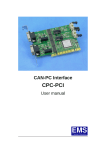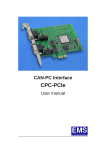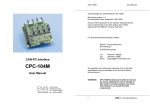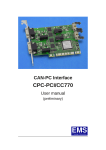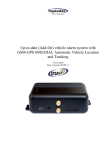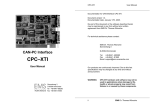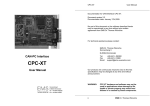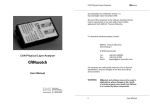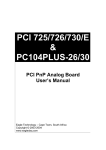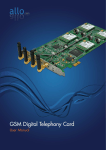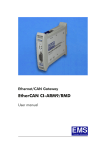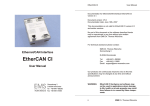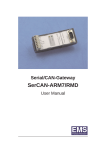Download CPC-104P User Manual - EMS Dr. Thomas Wünsche
Transcript
CAN-PC Interface CPC-104P User manual Thomas Wünsche CPC-104P User Manual User manual CPC-104P v1.01 Document version: Documentation date: 1.03 October 27th, 2010 No part of this document or the software described herein may be reproduced in any form without prior written agreement from EMS Dr. Thomas Wünsche. For technical assistance please contact: EMS Dr. Thomas Wünsche Sonnenhang 3 D-85304 Ilmmünster Tel. +49-8441-490260 Fax +49-8441-81860 Our products are continously improved. Due to this fact specifications may be changed at any time and without announcement. WARNING: 2 CPC-104P hardware and software may not be used in applications where damage to life, health or private property may result from failures in or caused by these components. EMS Dr. Thomas Wünsche CPC-104P User Manual Content 1 Overview 4 1.1 Attributes 1.2 General Description 1.3 Ordering Information 4 4 5 2 Programming Interface 6 3 Electrical Characteristics 7 3.1 Absolute Limiting Values 3.2 Nominal Values 7 7 Operating Instructions 8 4. 4.1 Configuration 4.2 Pin Configuration of CAN Connector 4.3 Installation EMS Dr. Thomas Wünsche 8 8 10 3 User Manual 1 CPC-104P Overview 1.1 Attributes • CAN interface for industrial applications • Compact size for PCI-104 or PC-104plus slots • CiA DS 102 and ISO 11898 compatible physical layer • Equipped with up to four CAN controller NXP SJA1000 • Galvanic decoupling between PC and CAN bus (optional) • Easy programming based on direct mapping of CAN controller registers into PC memory area • Extended temperature range 1.2 General Description CPC-104P is a PCI-104 plug-in card for the CAN bus. Designed for industrial series applications CPC-104P has a robust and cost efficient layout. CPC-104P supports up to four CAN controller of type NXP SJA1000. CPC-104P maps the CAN controller into the PC address space and thus allows access to CAN messages with low latency. Existing software for the supported CAN controller can easily be adapted. With CPC-104P the CAN communication may be handled either in interrupt controlled or in polled mode. CPC-104P can optionally be delivered with galvanic decoupling of the CAN bus. The dual and quad channel versions have the additional option of galvanic decoupling between CAN channels. 4 EMS Dr. Thomas Wünsche CPC-104P User Manual 1.3 Ordering Information 10-12-200-20 10-12-201-20 10-12-210-20 10-12-211-20 10-12-212-20 10-12-230-20 10-12-231-20 10-12-232-20 CPC-104P/SJA1000S PCI-104 CAN interface with one CAN controller NXP SJA1000 CPC-104P/SJA1000S-GTIS PCI-104 CAN interface with one CAN controller NXP SJA1000, galvanic decoupling CPC-104P/SJA1000D PCI-104 CAN interface with two CAN controller NXP SJA1000 CPC-104P/SJA1000D-GTID PCI-104 CAN interface with two CAN controller NXP SJA1000, galvanic decoupling CPC-104P/SJA1000D-GTI2S PCI-104 CAN interface with two CAN controller NXP SJA1000, individual galvanic decoupling CPC-104P/SJA1000Q PCI-104 CAN interface with four CAN controller NXP SJA1000 CPC-104P/SJA1000Q-GTI PCI-104 CAN interface with four CAN controller NXP SJA1000, galvanic decoupling CPC-104P/SJA1000Q-GTIS PCI-104 CAN interface with four CAN controller NXP SJA1000, individual galvanic decoupling EMS Dr. Thomas Wünsche 5 CPC-104P User Manual 2 Programming Interface CPC-104P is mapped into the PC memory space with a base address assigned by the PC BIOS. The availability of the CAN controller(s) in the memory area makes the CAN communication direct and provides a low latency time. The card is identified by the following parameters: Vendor ID Device ID Subvendor ID Subsystem ID : 0x10B5 : 0x9030 : 0x10B5 : 0x4002 CPC-104P incorporates a PLX9030 PCI to local bus bridge. BAR0 of the PCI configuration space register points to the bridge registers, whereas BAR2 plus an offset of 0x400 points to the first SJA1000 CAN controller. At offset 0x600, 0x800 and 0xA00 of BAR2 the optional second, third and fourth SJA1000 CAN controller can be accessed. Please contact EMS Dr. Thomas Wünsche for more detailed information about the programming interface of CPC-104P. 6 EMS Dr. Thomas Wünsche CPC-104P 3 User Manual Electrical Characteristics 3.1 Absolute Limiting Values Any (also temporary) stress in excess of the limiting values may cause permanent damage on CPC-104P and connected devices. Parameter Min. Storage temperature -40 85 °C Operating temperature* -40 85 °C Voltage on the bus connections -30 30 V - 1 A Current across ground connection Max. Unit * Extended temperature range on demand 3.2 Nominal Values Parameter Min. Typ. Max. Unit Power supply on +5V Pins of the PCI expansion slot 4.75 5.00 5.25 V Voltage on bus pins* -30 - 30 V - 16 - CAN controller clock frequency MHz * This potential is measured against the ground potential of the related CAN transceiver EMS Dr. Thomas Wünsche 7 CPC-104P User Manual 4 Operating Instructions 4.1 Configuration Due to the stack concept of PCI-104 the configuration switch (S1) of CPC-104P has to be set to a value corresponding to the module slot CPC-104P is installed. Switch Position (S1) Module Slot 0 or 4 1 1 or 5 2 2 or 6 3 3 or 7 4 The base address of the interface within the PC memory and the interrupt used is assigned by the PC BIOS. 4.2 Pin configuration of CAN connector The CAN interface connector (D-Sub 9 male) schema complies to CiA Standard DS 102. The pin usage is detailed in the following table: Pin 1 2 3 - Reserved by CiA, not connected CAN_L CAN dominant low GND CAN Ground 4 - Reserved by CiA, not connected 5 - Reserved by CiA, not connected 6 - Reserved by CiA, not connected 7 8 Name Description CAN_H CAN dominant high 8 - Reserved by CiA, not connected 9 - Reserved by CiA, not connected EMS Dr. Thomas Wünsche CPC-104P User Manual The strip connectors J1 and J2 on the PCB have the following connection scheme. J1 J2 1 not connected not connected 2 CAN1 GND CAN2 GND 3 CAN1 dominant low CAN2 dominant low 4 CAN1 dominant high CAN2 dominant high 5 CAN1 GND CAN2 GND 6 CAN3 dominant high CAN4 dominant high 7 CAN3 dominant low CAN4 dominant low 8 CAN3 GND CAN4 GND 9 CAN3 GND CAN4 GND 10 not connected not connected Pin Position of S1, J1 and J2 on the board J1 J2 S1 EMS Dr. Thomas Wünsche 9 CPC-104P User Manual 4.3 Installation CPC-104P may be installed in the board stack of a PCI-104 or PC104plus system only. To avoid damage please pay attention to the following hints: WARNING: Computer devices and components are sensitive against static discharge. For this reason keep CPC-104P in the antistatic cover until installing. Just before removing CPC-104P from the protection cover touch the metal case of your computer. Avoid damage by achieving equal potential between all devices on the CAN before plugging the connection. To the CAN adapter cable of CPC-104P only CAN networks with a connector and electrical characteristics complying with CiA DS-102 may be attached. PC interface and CAN bus are not galvanic decoupled in the standard version of CPC-104P. Use in systems with diverging ground potential of PC and CAN bus is not permitted in this case. Besides the instructions mentioned in this manual carefully observe the instructions in your coumputers user manual. If you are not sure about the installation please contact EMS Dr. Thomas Wünsche. 10 EMS Dr. Thomas Wünsche CPC-104P User Manual Execute the following steps for installation: • Disconnect your computer from the power line. • Open the case of your computer and locate the correct position on the PCI-104 stack. • Set the configuration switch of CPC-104P to the value corresponding to the stack level CPC-104P will be located. • Plug CPC-104P carefully onto the PCI-104 stack connector until it is completely seated. • Fix CPC-104P with the proper mounting material. • Attach the adapter cable connector to an appropriate position in the computers case and close the case. EMS Dr. Thomas Wünsche 11











